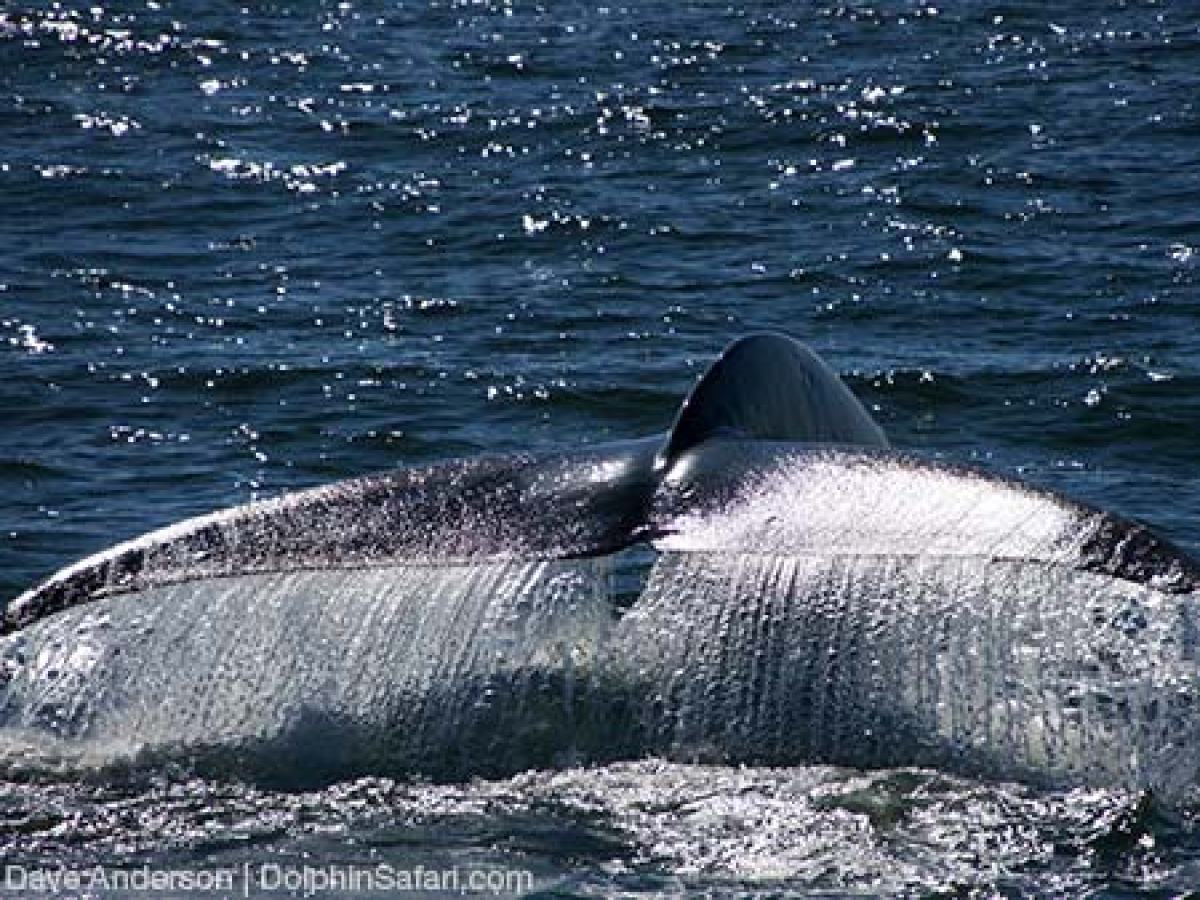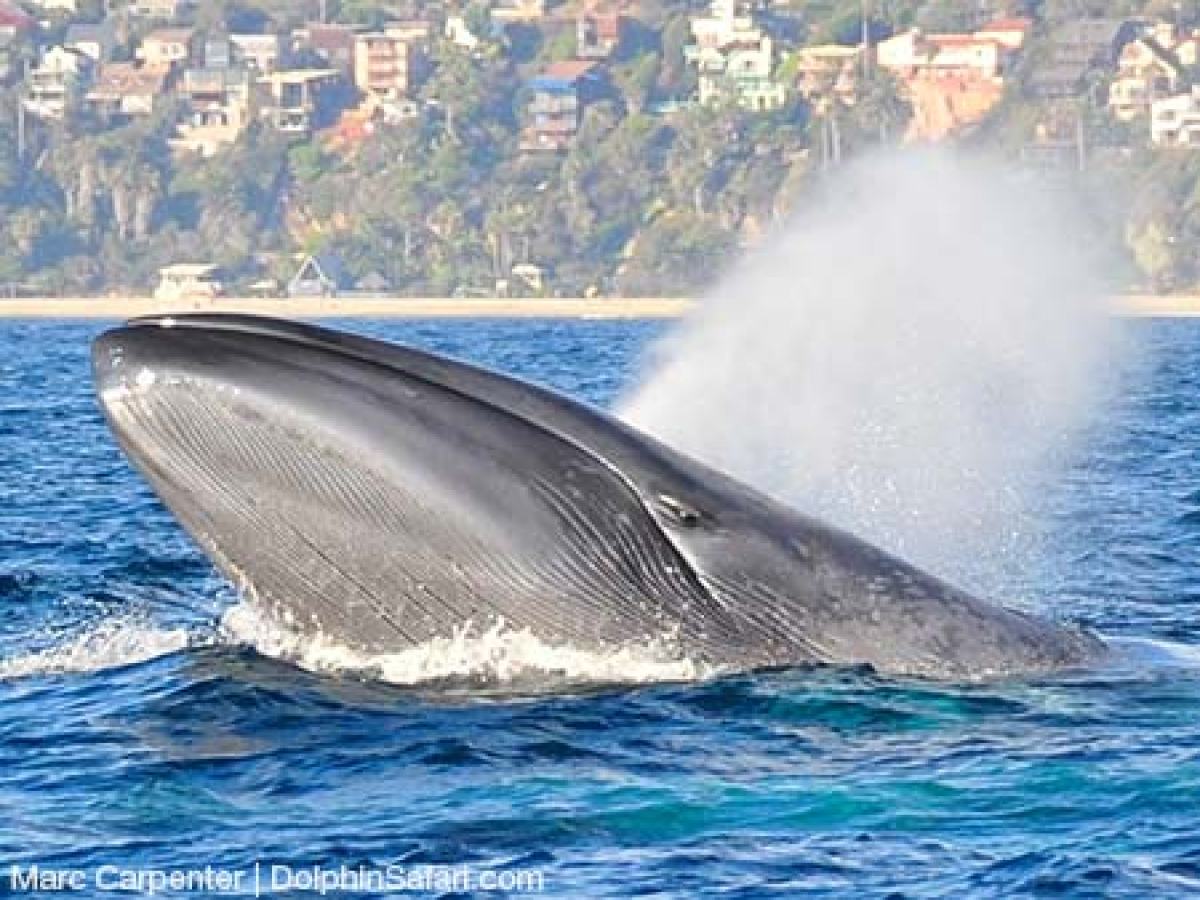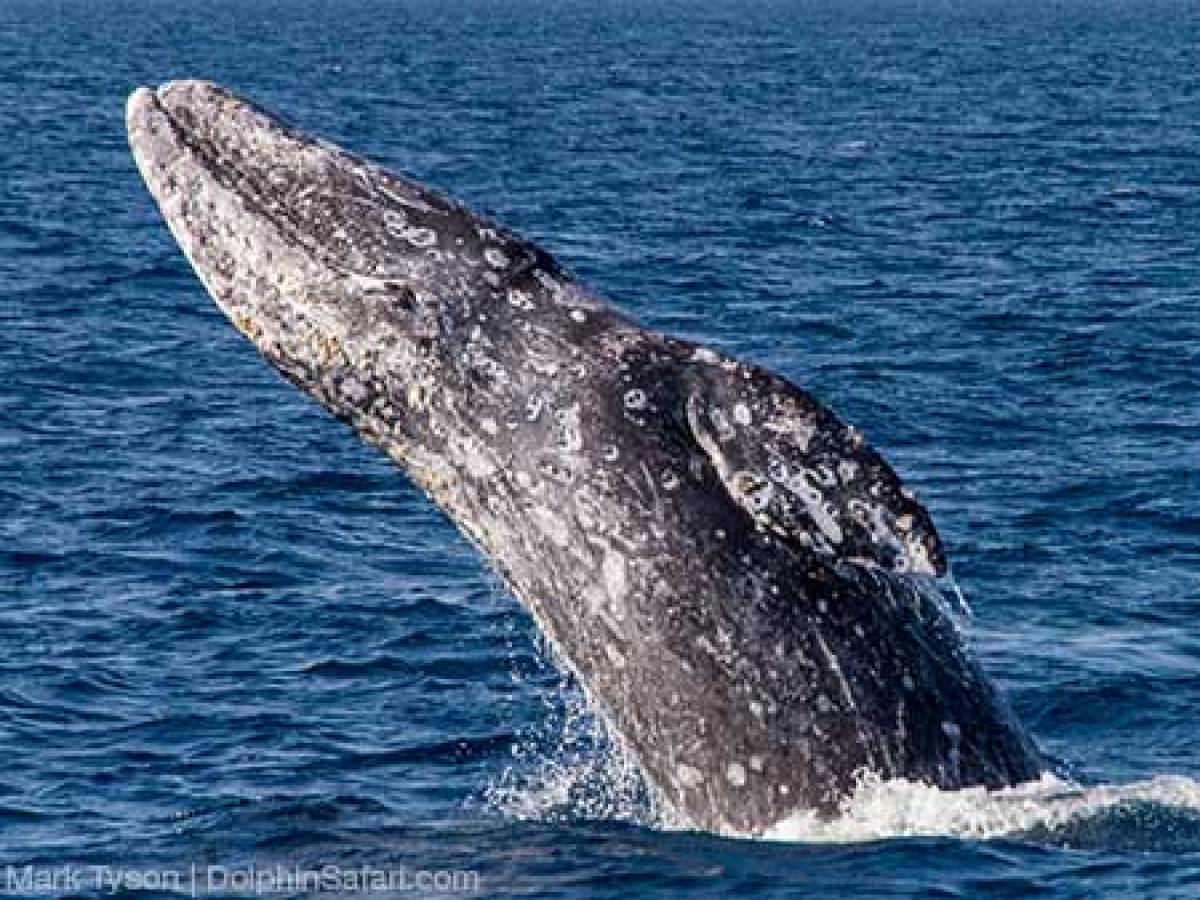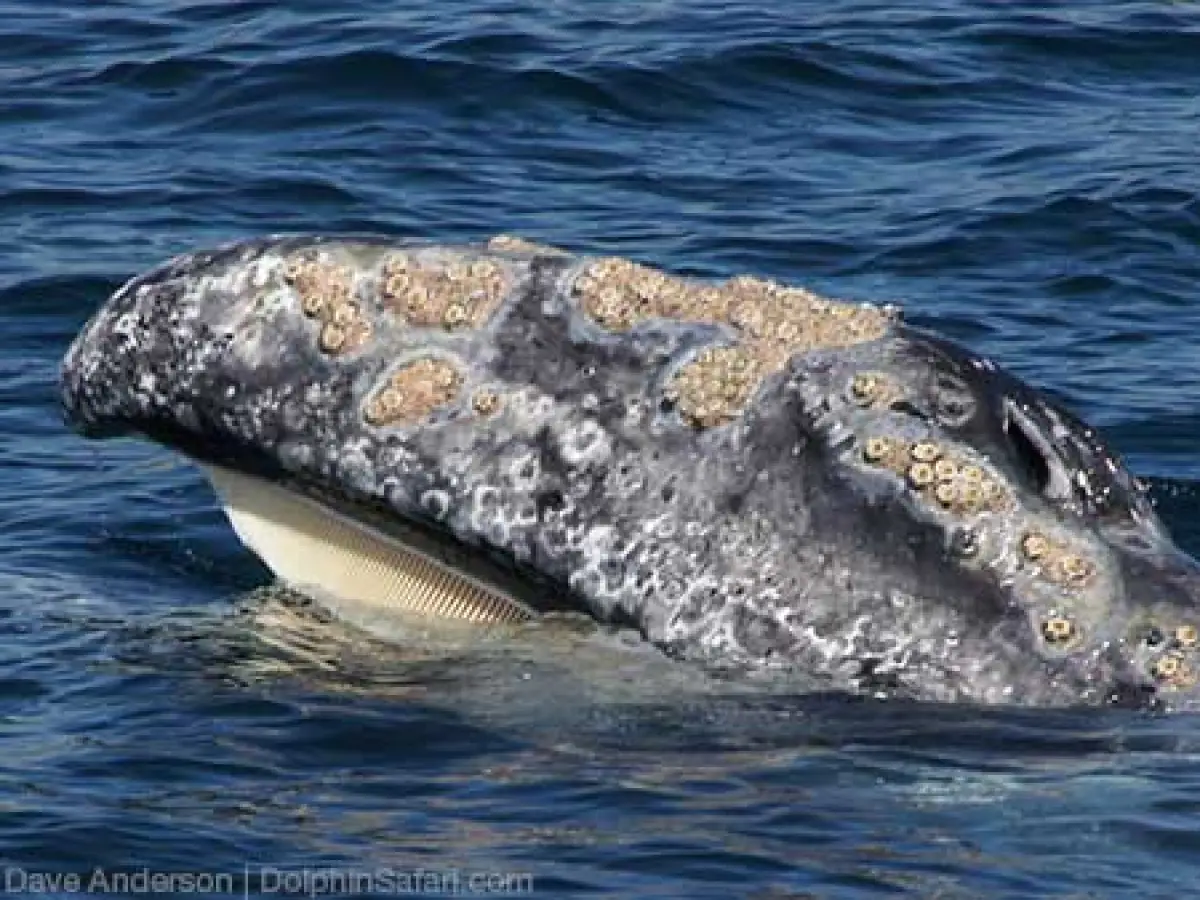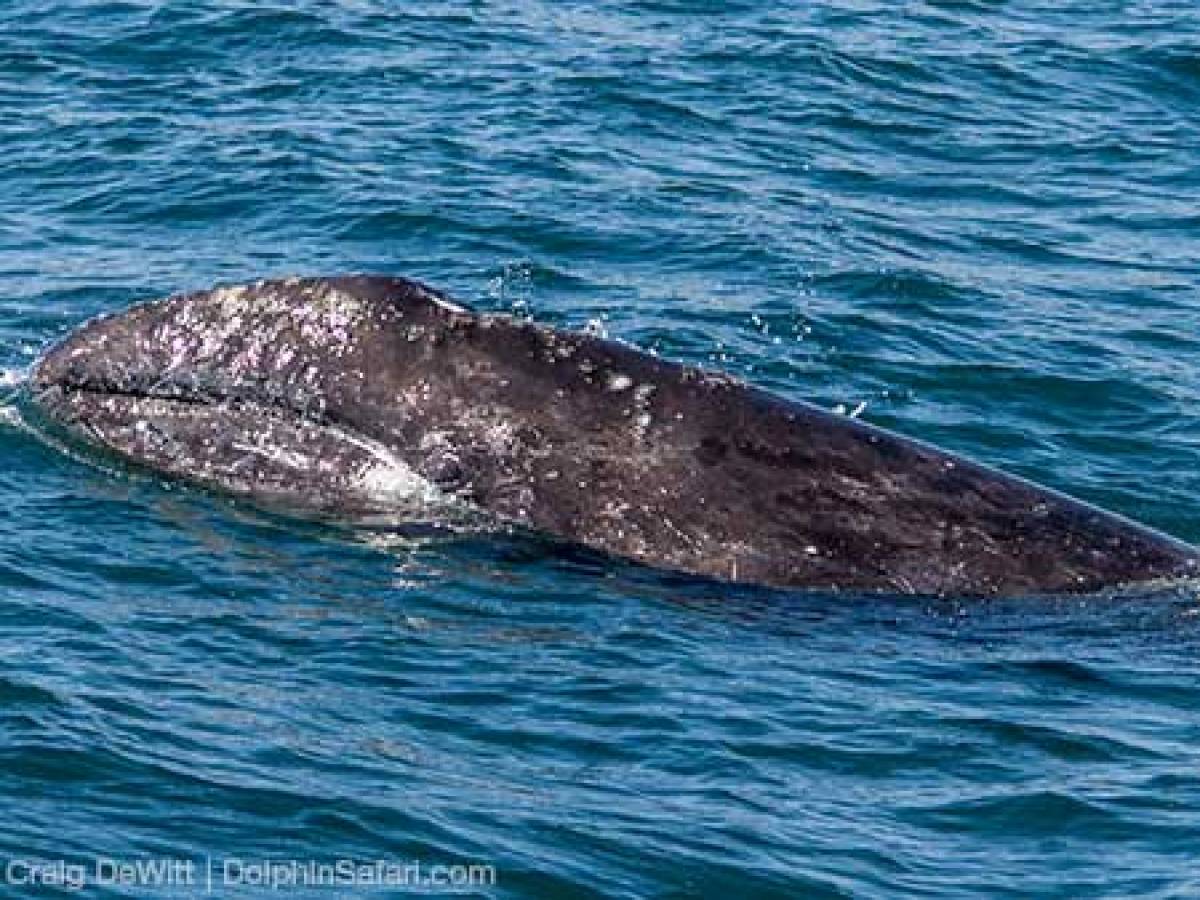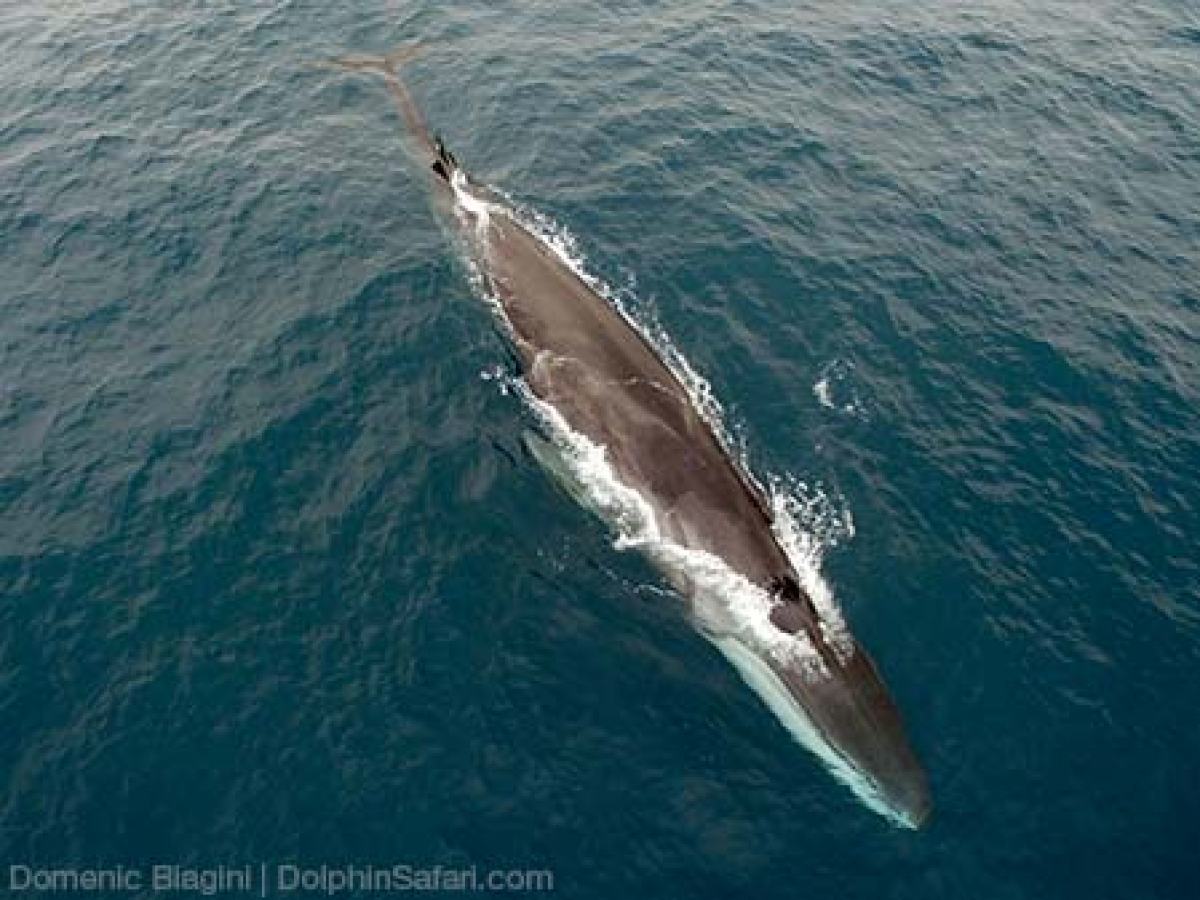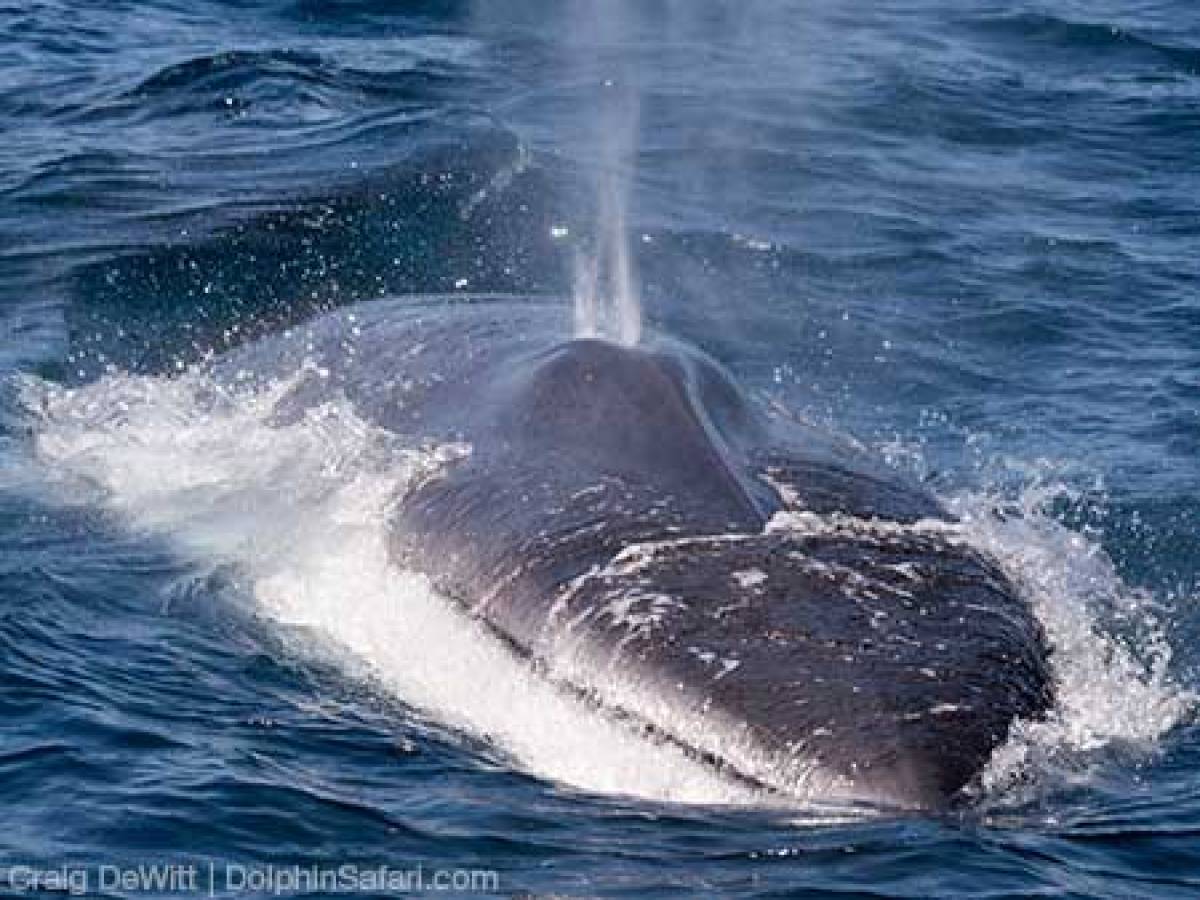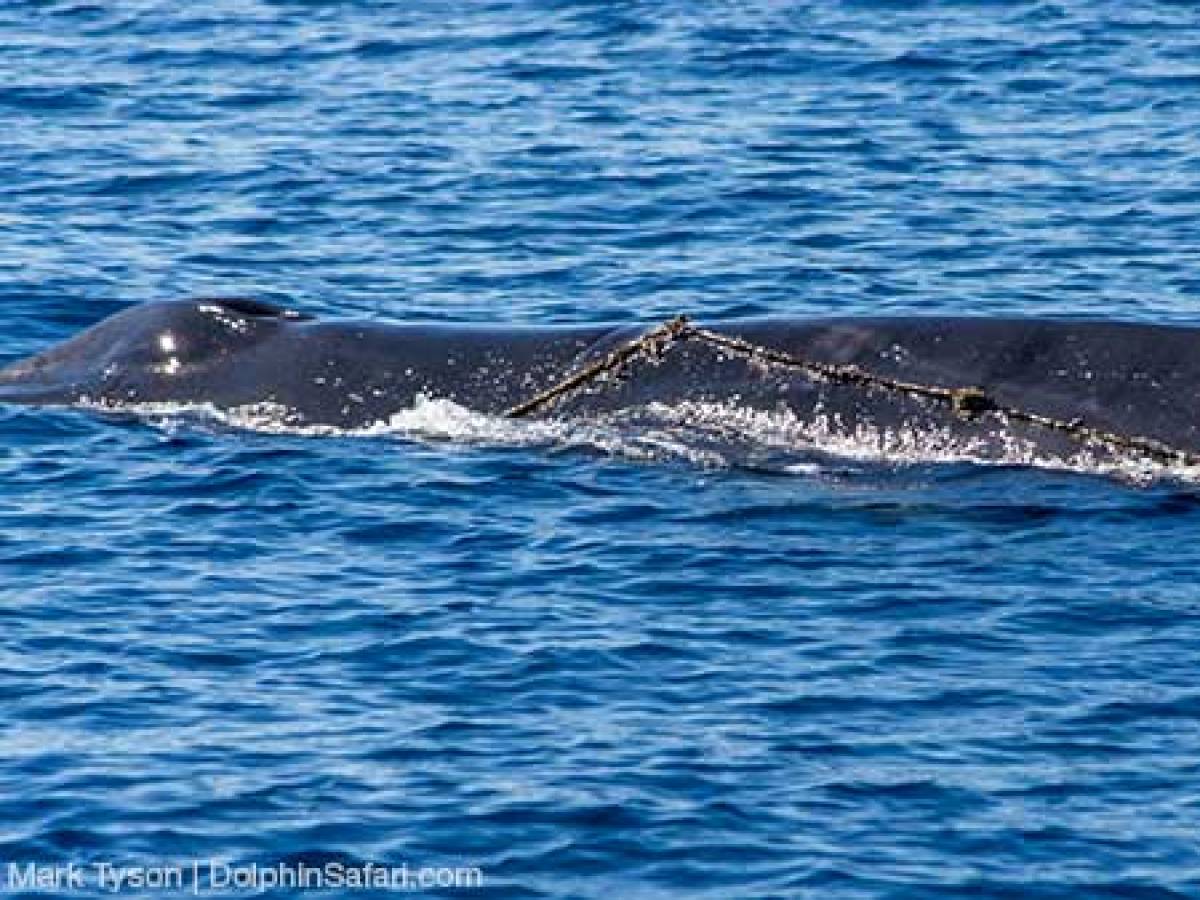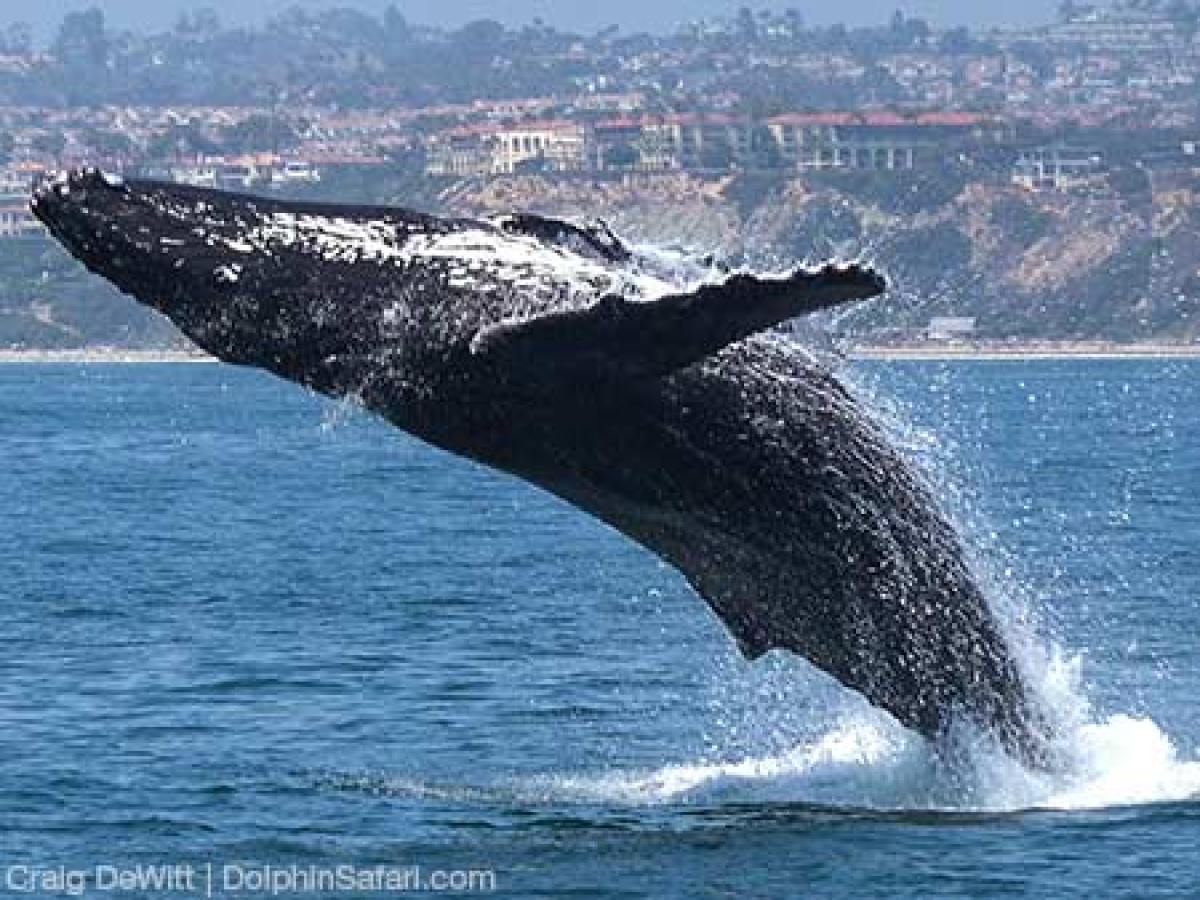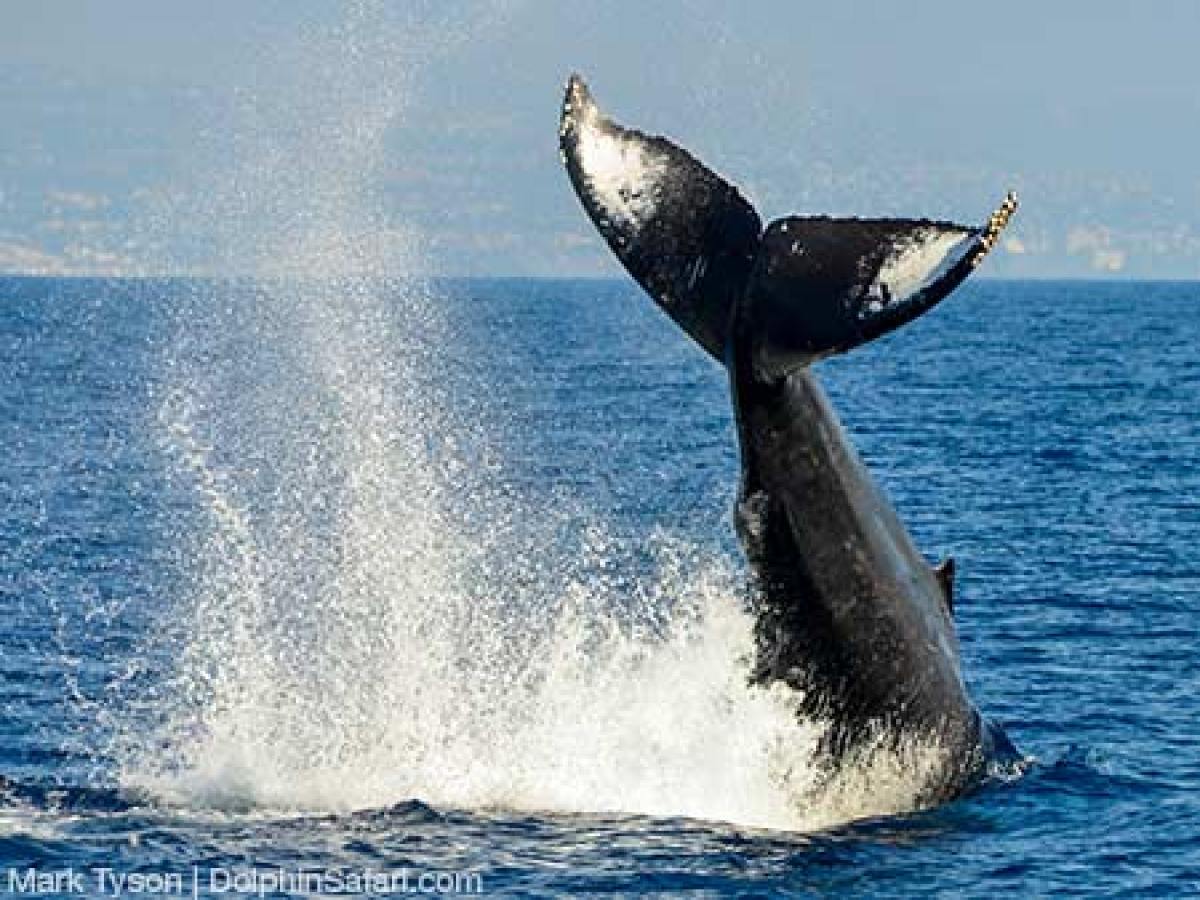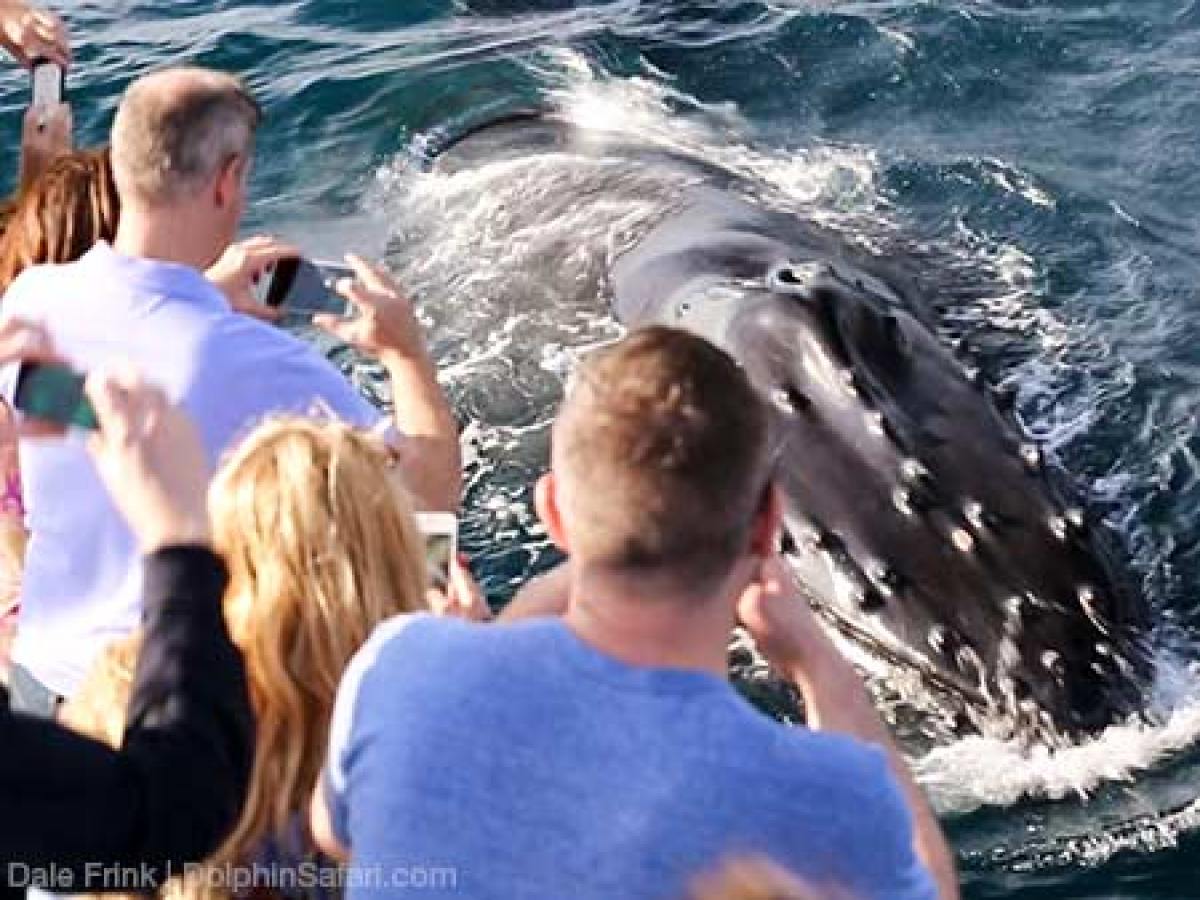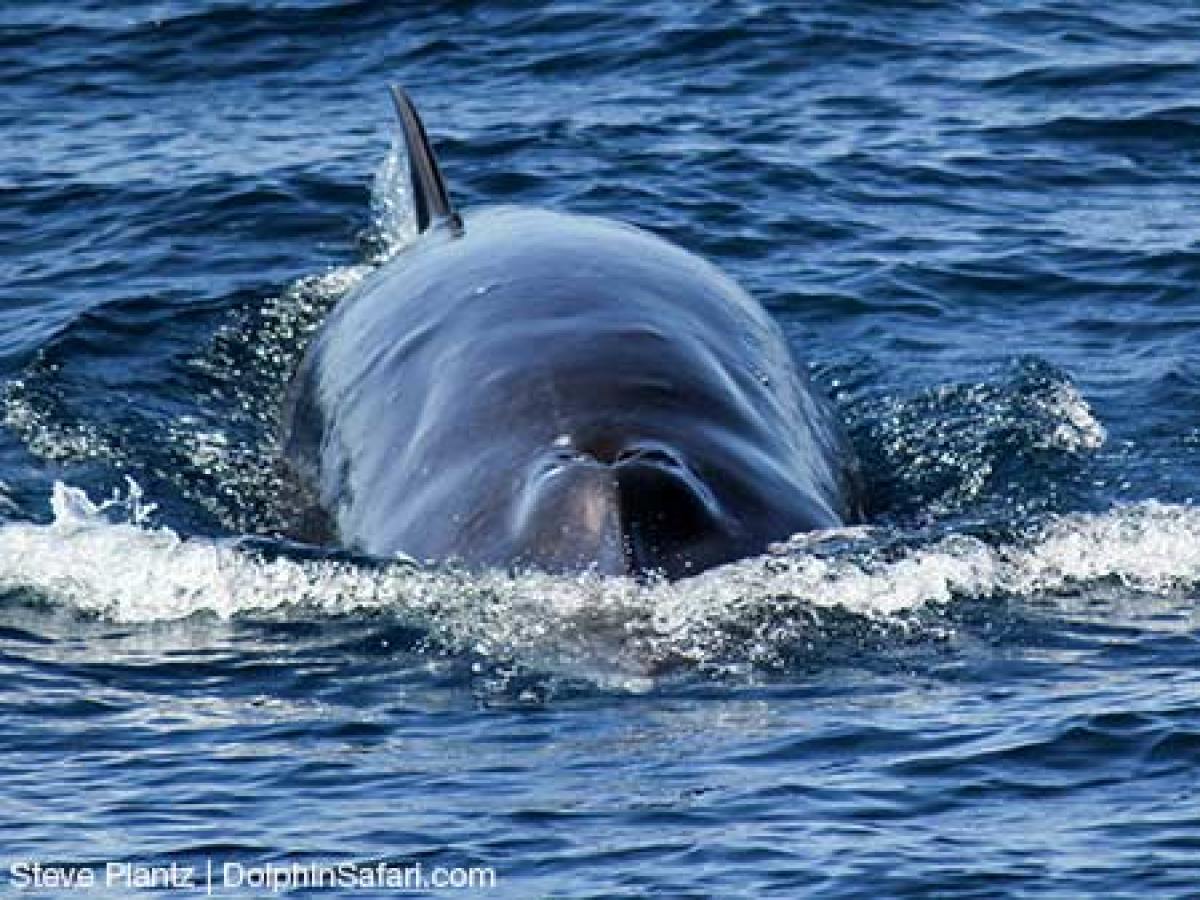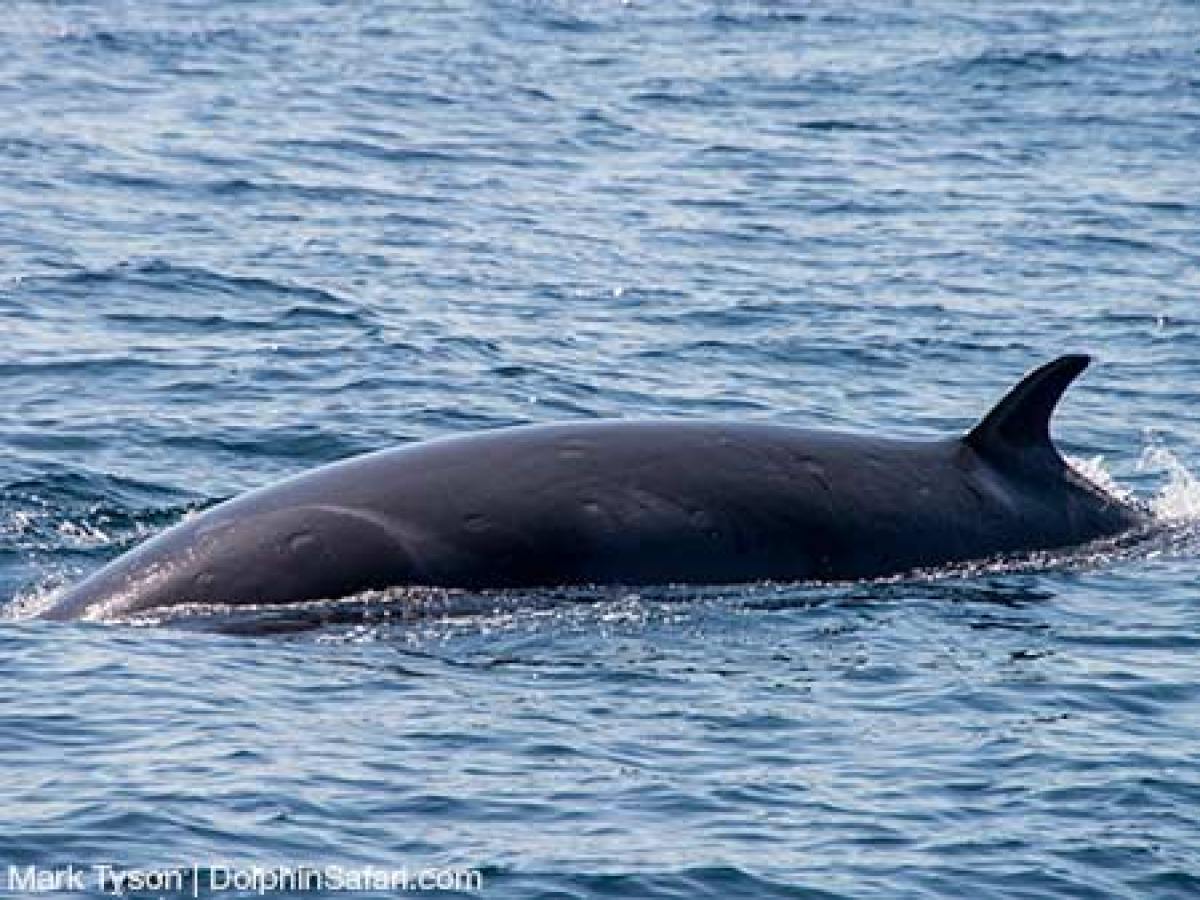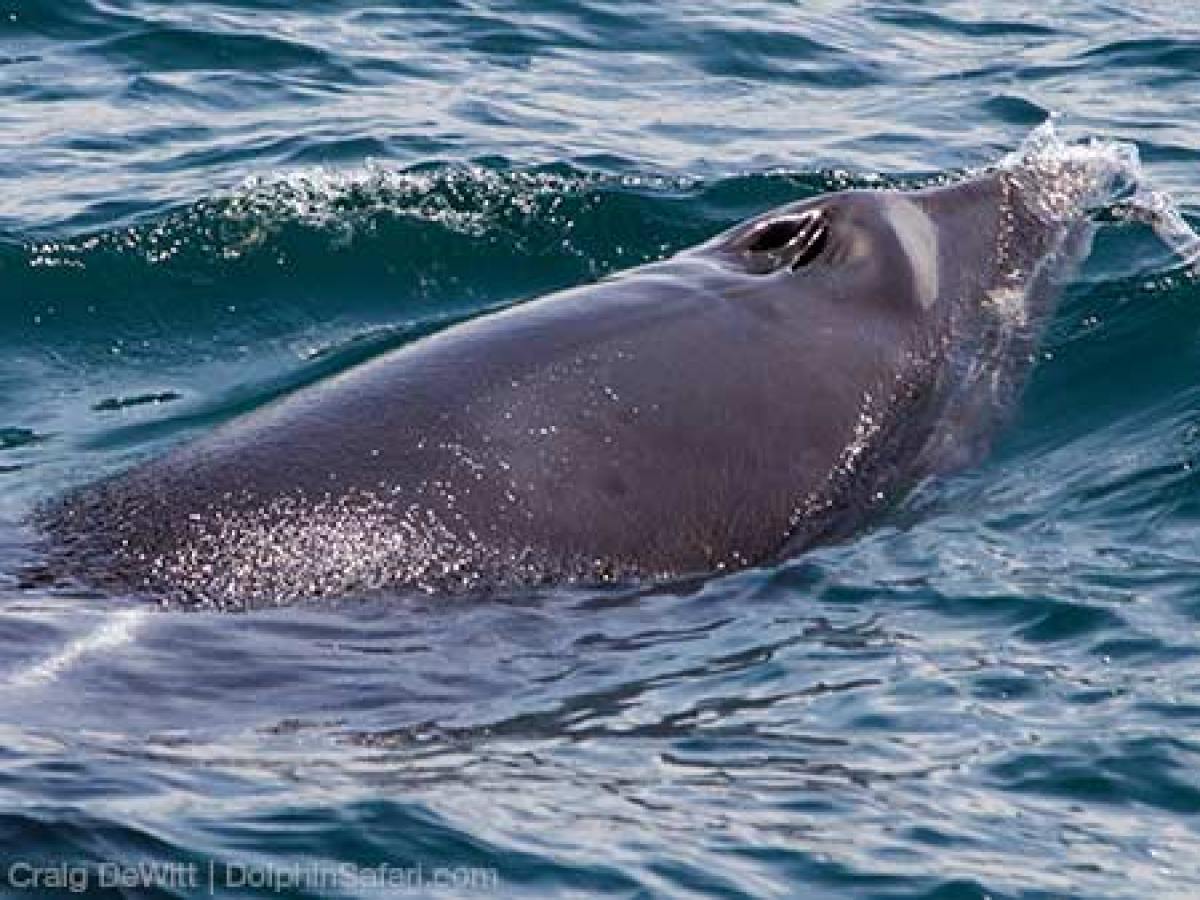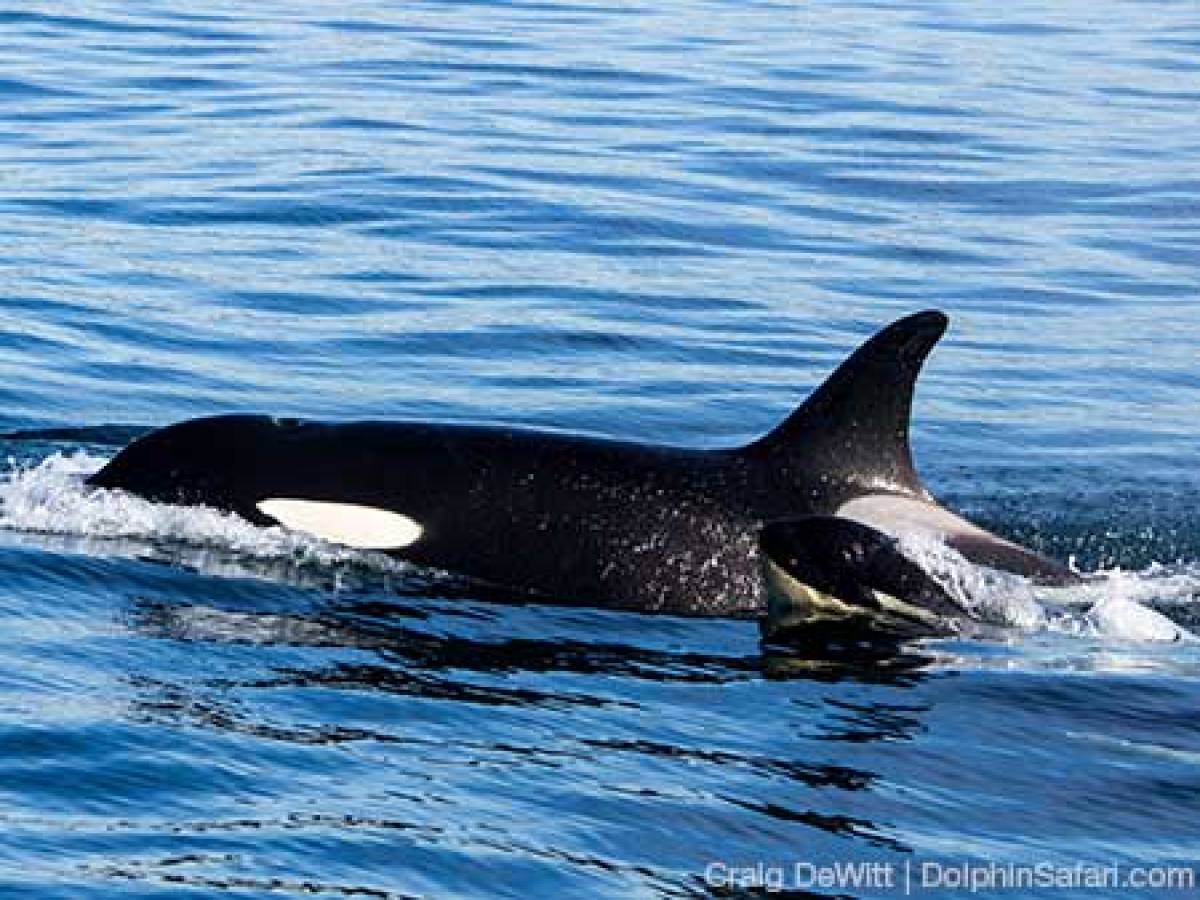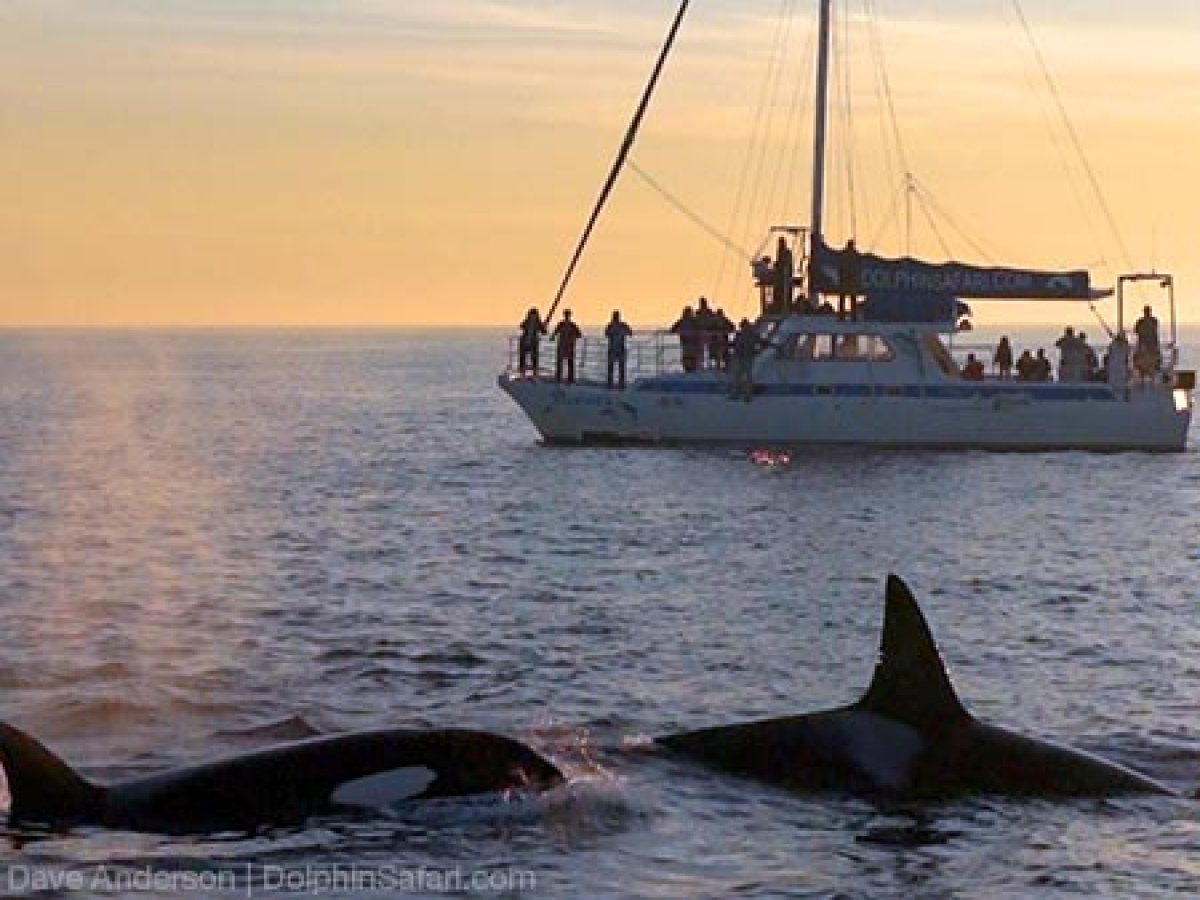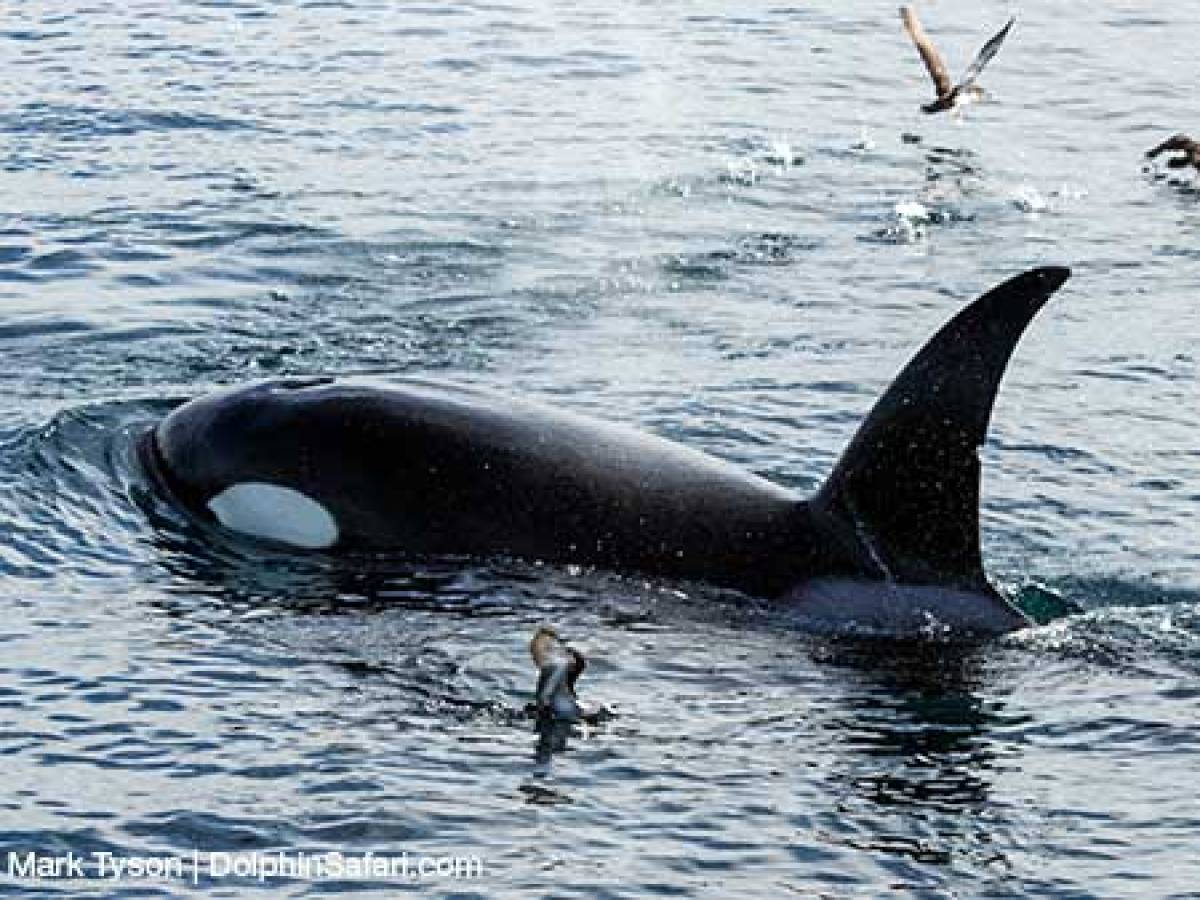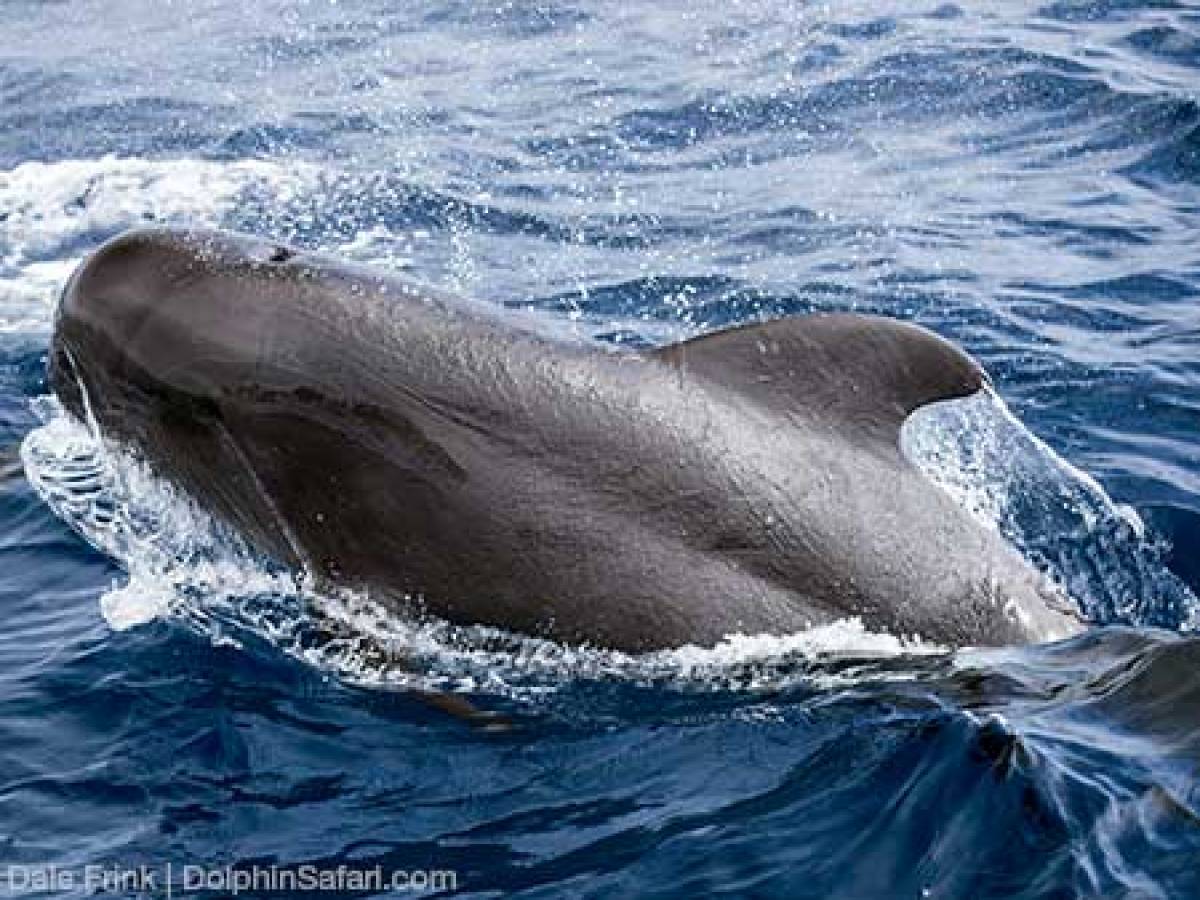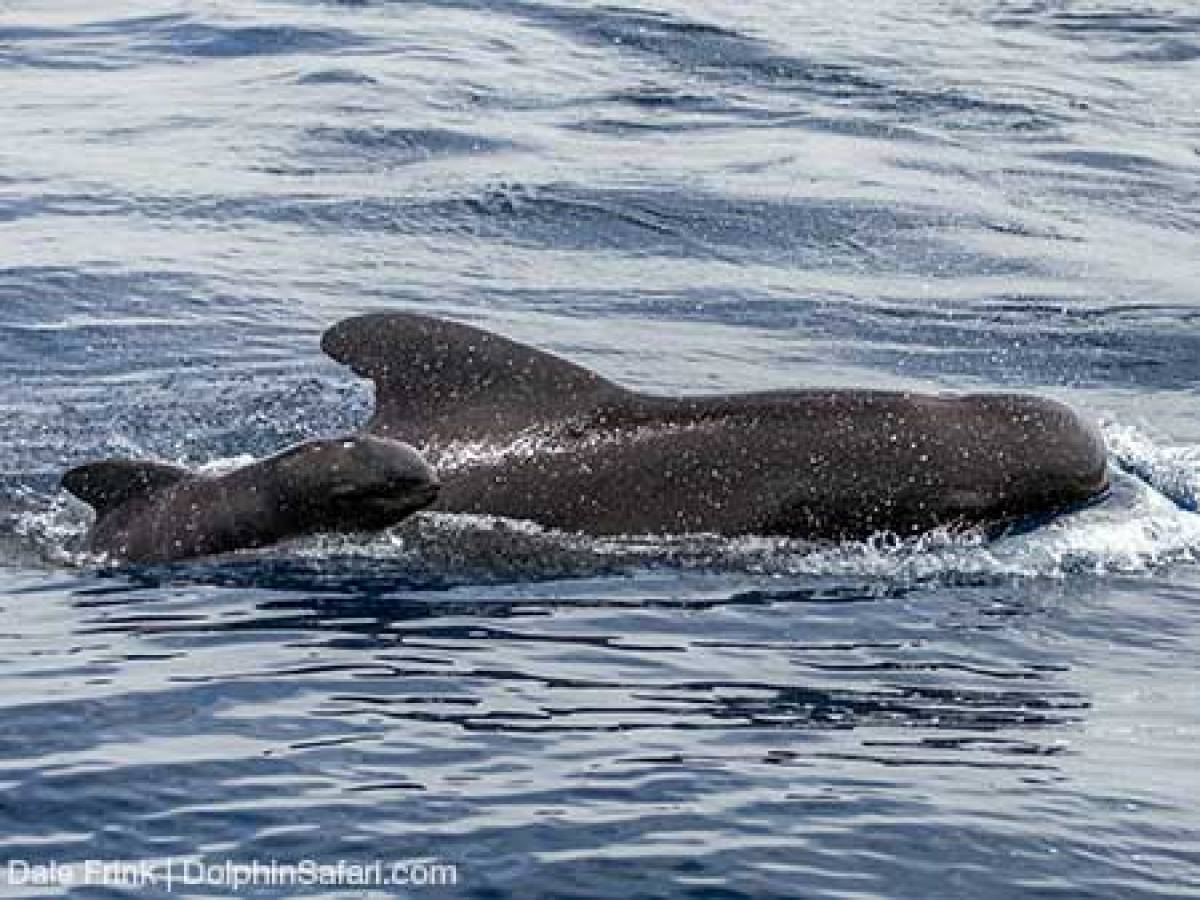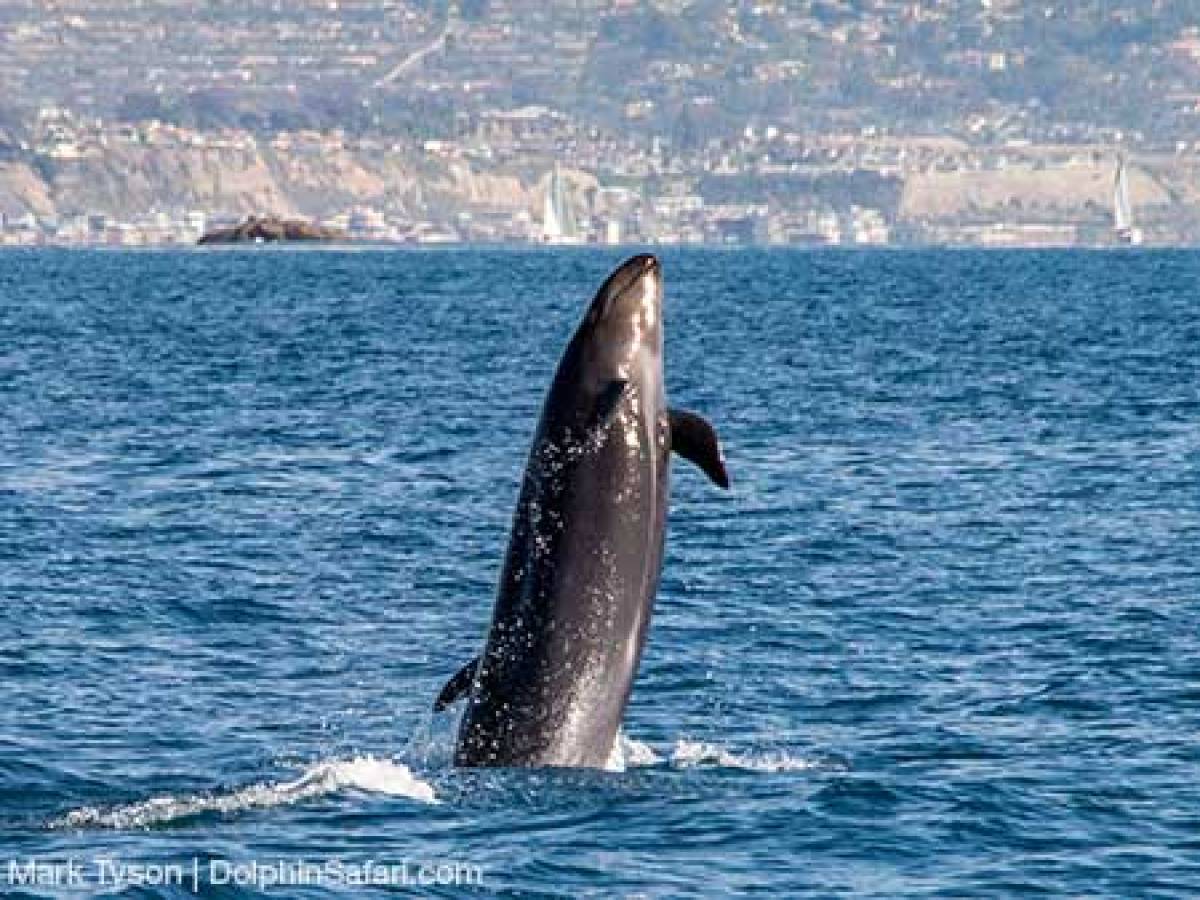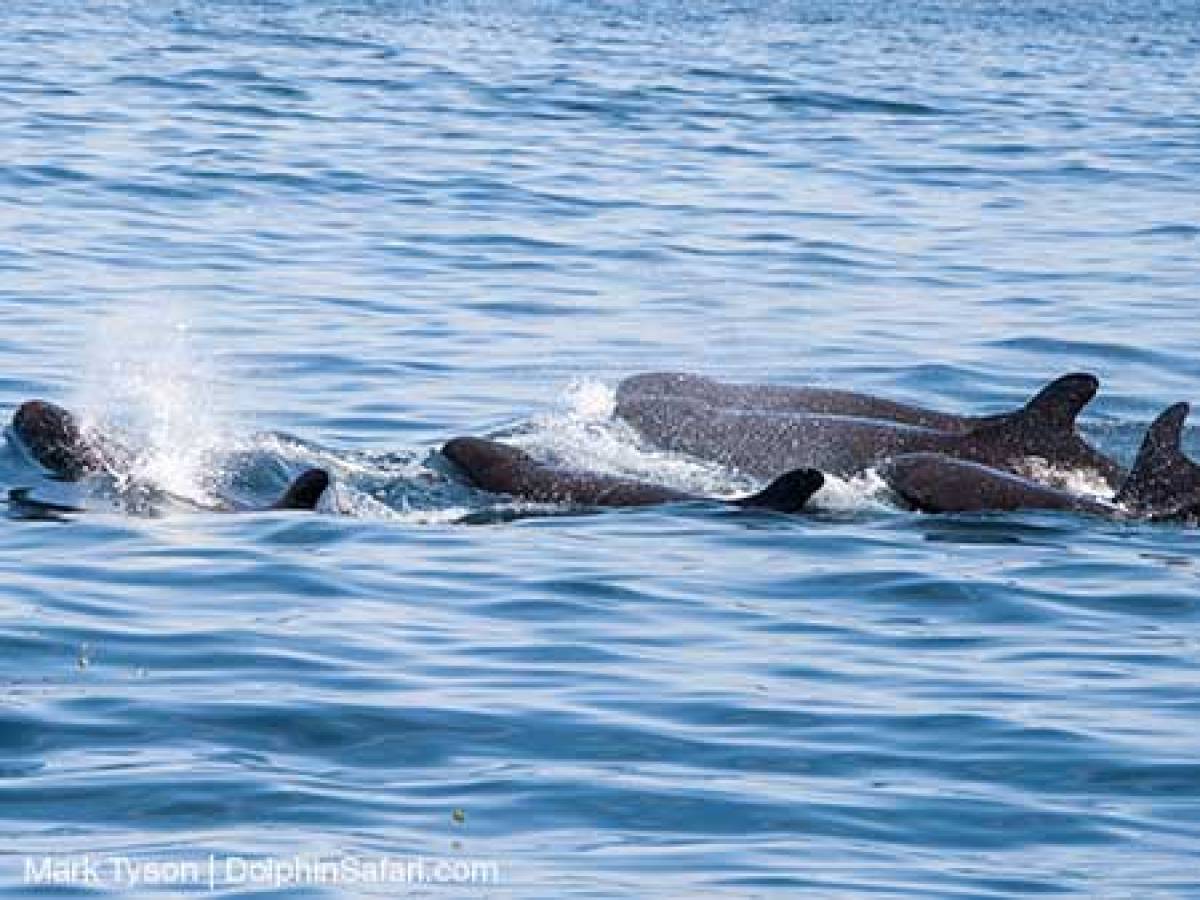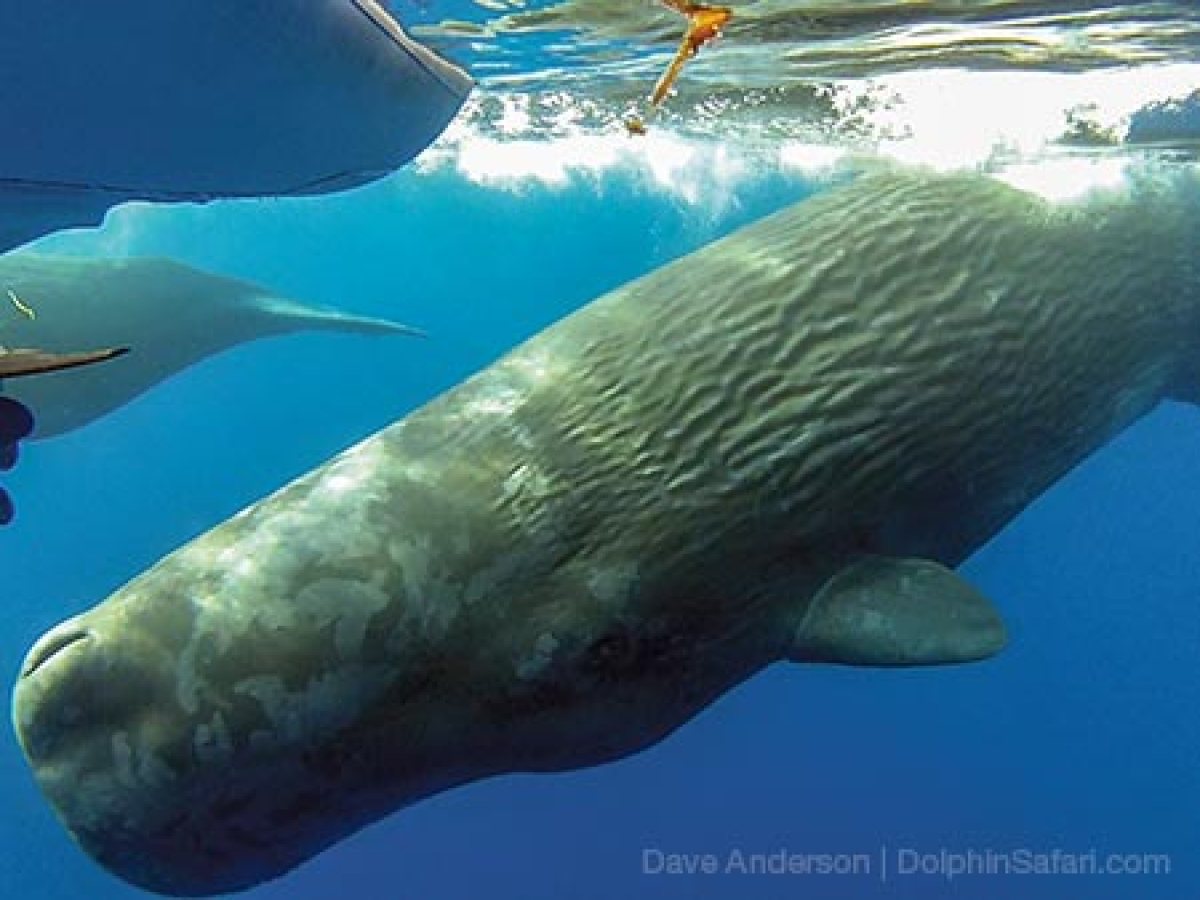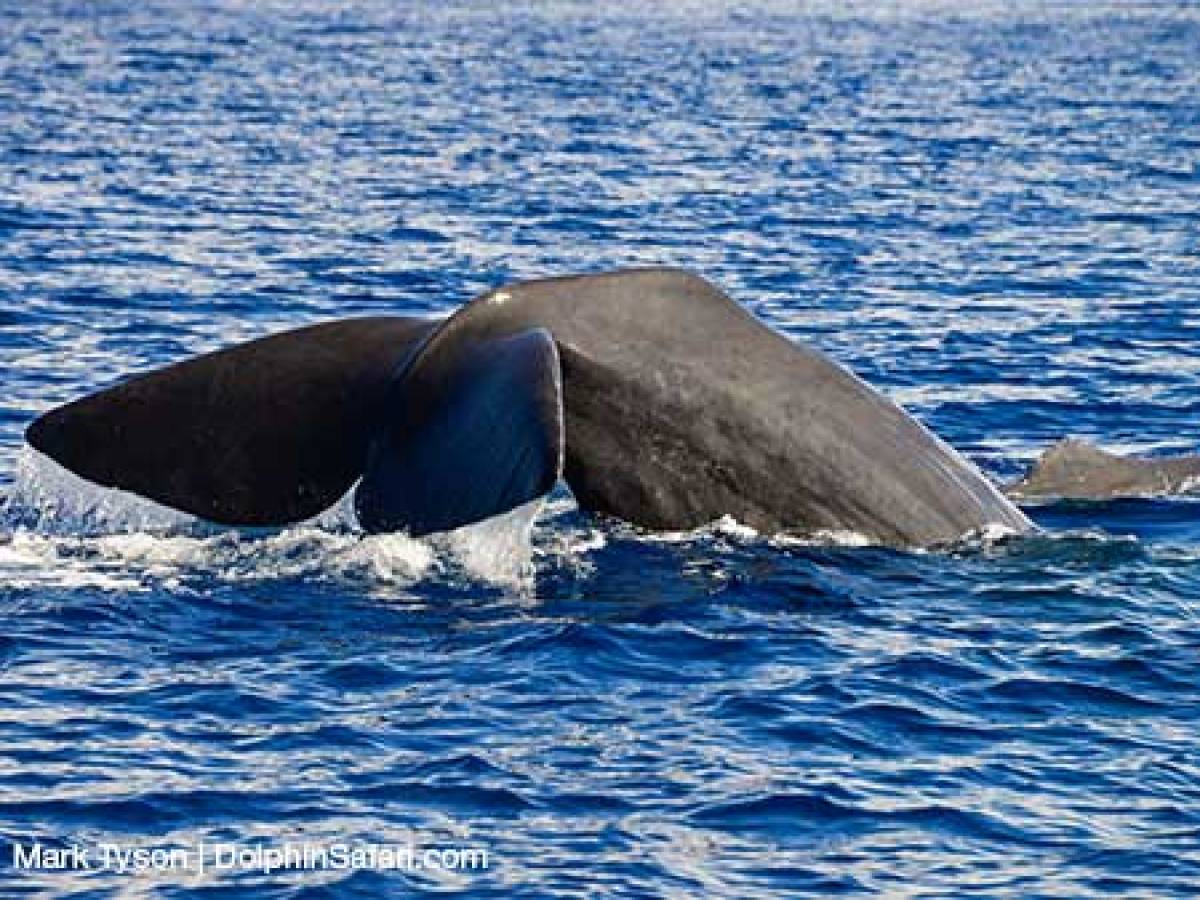Why is Dana Point the best place to see whales?
The waters off Dana Point are home to all types of whales as it is one of the most diverse marine ecosystems in the world. As a result, Capt. Dave’s whale watching eco-safaris view whales, dolphins, and other wildlife throughout the year. After all, every season is whale watching season in California! View slideshows below of the different types of whales we see!
All images in the following slideshows were taken during our whale watching safaris. Capt. Dave’s tours give you the chance to witness all types of whales in their natural habitat. Let’s dive in and learn more about the various species you might see!
-
Balaenoptera musculus
Whale watching season is year-round in California and there are all types of whales to be seen. One of the most majestic whales to witness is the blue whale. These magnificent animals have smooth skin, marked only by the remora fish that hitch a ride to feed off the krill that spills from their mouths. Their coloration is silver to light blue that can appear as brilliant azure under the water, with beautiful mottling that can be seen when up close.
When a blue whale surfaces and exhales, the sound is unlike anything you’ve ever heard. As their breath is released at approximately 200 miles an hour and forced through blow holes that have a striking resemblance to our own noses, the water is vaporized, shooting into the air, sometimes as high as 30 feet. The sound seems to thunder, then echo.
As its body glides through the water, it seems as if it will never end. Then as a bonus, the tail, measuring between 12 and 15 feet wide, will sometimes lift into the air, offering a magnificent display. The “oohs” and “aahs” abound.
Of all the types of whales, the blue whale is by far the biggest. As Capt. Dave says, “Bigger than the dinosaurs, bigger than Elvis, the only thing bigger than a blue whale is God and you hear Him mentioned a lot when a blue whale is around… people are always saying, “Oh, my GOD!”
The blue whale is, and always has been, the largest animal ever to exist on earth. This whale can grow to a length of 33m (110ft) and weigh 200 tons, about a ton per foot, but on average it is much smaller.
Blue whales are all considered a type of “rorqual”, which is the Norwegian word for “furrow”. It refers to the 55 to 68 pleated grooves running from its chin to the navel. The throat grooves, in addition to streamlining the shape of the whale, allow the throat area to expand tremendously during feeding and can hold 1,000 tons or more of food and water when fully expanded.
By taking tons of water into its mouth and filtering out the krill with its long, black baleen plates, a blue whale can eat over four tons of krill a day.
-
Eschrichtius robustus
What are gray whales? In short, gray whales are 40 to 50-foot lice covered, barnacle encrusted, mud sucking, bottom feeders. And we love them! Every year gray whales make one of the longest migrations of any mammal.
All gray whales are types of baleen whales that feed on small crustaceans called amphipods. But they don’t catch their food in the water column like blue whales. Instead, a gray whale dives to the bottom, rolls on its side, and scoops up mouthfuls of mud. The whale closes its mouth and pushes out the water and bottom sediment through baleen plates that hang from the whale’s upper jaw, leaving behind the amphipods to swallow.
The majority of gray whales spend the summer months feeding in the cold waters of the Bering and Chukchi seas, near Alaska. They have to eat as much as possible because in the fall, gray whales will start their annual 12,000 mile round-trip migration to the warm lagoons of Baja, Mexico, to mate and give birth to calves.
Throughout their migration, gray whales, like all types of whales and wildlife, face many challenges and hazards. Gray whales are slow moving, gentle animals and for these reasons, they often fall prey to transient (Bigg’s) killer whales. According to N.O.A.A. up to 35% of gray whale calves may be eaten by orcas. The greatest threat caused by humans is fishing gear entanglement. Nearly 1,000 whales and dolphins around the world die every day because of entanglement.
Capt. Dave organized Orange County’s first whale disentanglement group in 2008 and has successfully disentangled a variety of whale species, including several gray whales. In fact, the disentanglement of a whale named Lily made national headlines when she stranded herself inside Dana Point Harbor. Based on this experience, Capt. Dave has authored the award winning book, “Lily, A Gray Whale’s Odyssey”, a magnificent photographic journey of a gray whale’s migration.
During our Dana Point whale watching trips, we often see gray whales within a mile or two of the shore. Gray whales use Dana Point’s headlands as a landmark on their annual journey during whale watching season in California. It’s not uncommon to find these 30 to 40 ton animals breaching or spy-hopping outside of Dana Point Harbor in their effort to take a look around and get their bearings. While we see all types of whales on our cruises, we witness gray whales most frequently, especially in spring and winter. About 20,000 gray whales migrate past Dana Point every year.
In fact, every March, Dana Point celebrates the gray whale migration with the Festival of Whales. The Dana Point Festival of Whales began 43 years ago as an annual community event and now attracts nearly 100,000 visitors each year. Residents and visitors celebrate migrating gray whales, and all other types of whales and marine wildlife, with ocean-themed activities and presentations that emphasize education and environmental responsibility.
Fin Whale
-
Balaenoptera physalus
Fast and sleek, fin whales are the second largest whale after the blue whale, with adults measuring 70 to 80 feet. Sometimes called finback whales, they can weigh as much as 80 tons. Fin whales, like blue whales, are rorquals that have throat grooves which expand when feeding. Fin whales eat krill and schooling fish.
All fin whales have a type of unique asymmetrical coloring under their lower jaw, with gray or black on the left side and white on the right. They have light gray, v-shaped “chevrons” behind their head and tall, curved dorsal fins.
The fin whale is a fast swimmer leading to the nickname “greyhound of the sea”. It is able to swim in short bursts of up to 23 miles per hour. Thanks to its size and speed, the fin whale’s only non-human predators are killer whales.
Although fin whales rarely show their tail flukes and almost never jump out of the water (a behavior called breaching), they can be very friendly towards boats. Several have seemingly enjoyed the company of our whale watching catamarans and will approach the boat, even looking at passengers in our Underwater Viewing Pods!
Unfortunately, fin whales are considered an endangered species. While some fin whales are still hunted in other areas around the world, in the U.S. they face threats which include ship strikes and entanglement in fishing gear.
Humpback Whale
Minke Whale
-
Balaenoptera acutorostrata
At just 26 to 30 feet in length, minke whales are the smallest baleen whales seen on our tours during whale watching season in California. Minke whales have dark gray to black coloring on top, white coloring on the belly, and distinctive white bands around the middle of their pectoral flippers. Their dorsal fins are tall and curved.
Like their larger family members, all minke whales are also a type of rorqual with 50 to 70 ventral pleats that expand like a balloon when feeding. They eat by taking in large amounts of water and food (such as krill or small schooling fish), pushing the water back out through 230 to 360 cream colored baleen plates, and swallowing the food that has collected.
Minke whales are fast swimmers and don’t spend much time at the surface, so they can be a challenging whale to watch. Still, there are some that can be outgoing and curious about boats. They will come over and swim close to the boat, which is called a “mugging”. Once in a while they’ll jump out of the water (breaching)!
Of all the rorquals in the world, minke whales are the type that are the most abundant. However, minke whales, many of which are pregnant females, are still hunted in some countries around the world including Japan, Iceland, and Norway.
-
Orcinus orca
Killer whales are a type of whale that are all instantly recognizable by their beautiful black and white coloring and tall dorsal fins (a male dorsal fin can reach up to 6 feet tall). Killer whales are actually members of the dolphin family and have the distinction of being the largest dolphin in the world! They can reach lengths of 23 to 32 feet and weigh 4 to 9 tons depending on gender.
Killer whales are apex predators and have been known to prey on animals as large as blue whales and as fierce as great white sharks. Despite that, the good news is there are no known instances of a wild killer whale harming a human.
There are 2 ecotypes of killer whales that visit. Transient (Bigg’s) killer whales are the most commonly seen type of all. Transient killer whales feed on other marine mammals including gray whales, dolphins, and sea lions. We also get visits from rare offshore killer whales, an ecotype that is one of the least understood. Offshore orcas are thought to feed on fish, including sharks.
A third population of rarely encountered killer whales, Eastern Tropical Pacific (ETP), have been seen off the coast of Southern California during whale watching season, although these are not known to belong to an ecotype. Very little is known about the ETP killer whale population.
Pilot Whale
-
Globicephala macrorhynchus
Pilot whales, like killer whales, are members of the dolphin family. They love to eat squid but they will consume fish too. They can dive down to 1,000 feet or more to catch prey. Pilot whales are large, with adult males averaging around 18 to 20 feet in length, and can weigh over 2,200 pounds. They’re second in size only to killer whales and highly intelligent.
All pilot whales have dark brown or dark gray color with a gray saddle behind the dorsal fin. They have a bulbous head and almost no beak. According to N.O.A.A. there are an estimated 300 pilot whales off the coast of California, Oregon and Washington combined.
Pilot whales were once more common to Southern California but disappeared from the area over 30 years ago after an El Niño event caused the squid population to decrease. Scientists don’t know exactly why they’re not here anymore as there are plenty of squid now. Thankfully, there are plenty of other whales to see during whale watching season in California. In fact, about the time pilot whales left the area, Risso’s dolphins (who also eat squid) began appearing.
False Killer Whale
-
Pseudorca crassidens
All false killer whales are a type of whale that are actually members of the dolphin family, just like orcas. They are dark gray/brown, with areas of light gray on its throat and chest. False killer whales can reach lengths of 15 to 20 feet and weigh about 1,500 pounds. They eat fish and cephalopods (like squid).
In 2014, we had our first false killer whale sighting in nearly 10 years. During the encounter, Capt. Dave, who was in his own small inflatable boat, had 5 whales come over and surround him. Watch what happens when one curious whale approached within 4 inches of his GoPro!
In 2016, we had another breathtaking encounter with this type of whale that left all of us in awe. This time, a pregnant female came over to our whale watching catamaran, Manute’a, pushed against us, and gave birth to a calf! The pod surrounded the calf and spent the next 10 minutes taking turns pushing the calf to the surface while it learned how to swim. Watch the video.
False killer whales are outgoing animals and, like other dolphins, form strong social bonds. They’re usually seen in groups of 10 to 20, that are part of a much larger pod. False Killer Whales can be found with other large cetaceans such as bottlenose dolphins seen off the coast of Southern California.
-
Physeter macrocephalus
Sperm whales can reach lengths of up to 59 feet, weigh up to 45 tons, and are the largest toothed whale in the world! They can dive to depths over 3,300 feet and hold their breath for over an hour, making them the second deepest diving marine mammal after the Cuvier’s beaked whale. Of all the various types of whales, they have the largest brain of any known animal on Earth.
In 2014, during the prime whale watching season in California, a pod of over 60 sperm whales visited Dana Point, California. It was the first time whale watching trips had seen sperm whales in decades. The whales were seen in about ten groups of about eight to twelve whales each, spread over two to three miles just three miles off the Dana Point Harbor. The groups would surface for as much as 15 minutes at a time, occasionally approaching the boat to spy hop, roll, tail lob and fluke.


